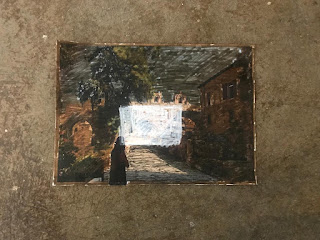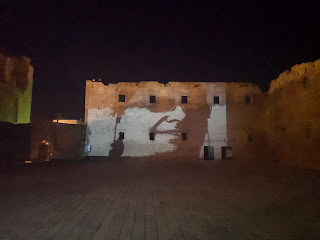Negotiating between the familiar and unfamiliar: new approaches in portraiture and architecture by Vasilis Vasiliou
Curator's Cut (Ellada)
This was my second time working with Vasilis. The first time, it was rather remotely, I was not directly involved in the FA/DE mural project in which he was working with Nurtane Karagil to produce a mural in Deryneia. However, following the process of their work intrigued me, the complete exposure of public art, the permanent impermanency, and how an artist goes through their own process to create.
What you see below is a conversation i had with Vasilis on the morning of Oct. 13th. what you see in italics, are my comments:
i asked about his difficulties, with his own creative process:
- he started off with an interest to collect information from
architecture and the past of Famagusta. The
difficulty would be to break it down and put it together as a concept. The process entailed studying a lot, collecting info, and breaking it down to visuals. True to his process, on Wednesday lunchtime he had a blackout. he had a moment that he thought he would not be able to get out, to re-emerge from the research.
what unlocked him:
- the critical review, it was then that he understood what he
was doing. He became familiar with what he was doing and merged it with the
techniques he has been using.
what kept him curious about the subject matter:
-
on his visits to Famagusta, he discovered ruins and architecture. it was interesting that they were in such a
small space. the concentration of relics of the past* in Famagusta is indeed impressive, they exist among the living, as a constant reminder of the layers of history and memory. The process was interesting, to have a walk through history. it was creating a
route through the buildings/ monuments that was not easy.
*Historian Eric
Hobsbawm in "Age of Empire" (1987) calls historical time before personal memory as “remote
periods”. He claims that “such periods
may survive exclusively through the inanimate relics of the dead: words and
symbols, written, printed or engraved, material objects, images.” (4). Famagusta presents such a rich collection of relics, that a feeling of loss is completely justified: materials, symbols, styles, narratives, overlapping, consecutive and concurring.
what is the difference with his earlier work:
- sometimes he tries to communicate
immediately what he feels and what he does. information came from his own experience. he was researching through humans, observing behaviour and understanding it; a more socio-cultural observation.
This project was personal in another way. he did not position himself when creating the work.
“fly on the
wall portraiture”
He advanced the way he understands and conducts research. Gulgun’s help and the Critical review process allowed him to break down the elements.
why did he use a live model for the portrait in the artwork:
-
when he was lost, he asked Nurtane if she would pose for him. he felt that if he did something with
someone he knew, it would simplify things. going back to more rooted situations. the comfort of a human body, next to the rough texture of buildings and historical narratives, the familiarity of a voice and a breath, next to the voiceless and endlessly manipulated.



























